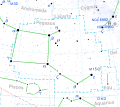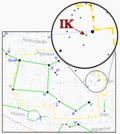51 Pegasi b, officially named Dimidium /dɪˈmɪdiəm/, is an extrasolar planet approximately 50 light-years (15 parsecs) away in the constellation of Pegasus...
16 KB (1,611 words) - 12:05, 17 October 2024
51 Pegasi (abbreviated 51 Peg), formally named Helvetios /hɛlˈviːʃiəs/, is a Sun-like star located 50.6 light-years (15.5 parsecs) from Earth in the constellation...
22 KB (1,814 words) - 05:52, 7 October 2024
and 2.45, the brightest star in Pegasus is the orange supergiant Epsilon Pegasi, also known as Enif, which marks the horse's muzzle. Alpha (Markab), Beta...
37 KB (3,919 words) - 13:42, 29 October 2024
Epsilon Pegasi (Latinised from ε Pegasi, abbreviated Epsilon Peg, ε Peg), formally named Enif /ˈiːnɪf/, is the brightest star in the northern constellation...
18 KB (1,711 words) - 15:52, 26 October 2024
Gamma Pegasi is a star in the constellation of Pegasus, located at the southeast corner of the asterism known as the Great Square. It has the formal name...
16 KB (1,441 words) - 10:05, 26 October 2024
Beta Pegasi (β Pegasi, abbreviated Beta Peg, β Peg), formally named Scheat /ˈʃiːæt/, is a red giant star and the second-brightest star (after Epsilon Pegasi)...
13 KB (1,016 words) - 00:38, 8 September 2024
IK Pegasi (or HR 8210) is a binary star system in the constellation Pegasus. It is just luminous enough to be seen with the unaided eye, at a distance...
46 KB (5,202 words) - 04:42, 23 August 2024
U Pegasi is a binary star system in the constellation of Pegasus, abbreviated U Peg. The pair form an eclipsing binary with a combined peak apparent visual...
18 KB (1,559 words) - 21:12, 6 October 2024
of a few stellar radii. X-ray flares from II Pegasi A were observed with the Ariel 5 satellite in the 1970s and with later X-ray observatories. In December...
7 KB (505 words) - 15:45, 18 July 2024
IM Pegasi is a variable binary star system approximately 329 light-years away in the constellation of Pegasus. With an apparent magnitude of 5.7, it is...
7 KB (578 words) - 14:11, 18 July 2024
LL Pegasi (AFGL 3068) is a Mira variable star surrounded by a pinwheel-shaped nebula, IRAS 23166+1655, thought to be a preplanetary nebula. It is a binary...
9 KB (710 words) - 21:04, 6 November 2024
asterism consisting ζ Pegasi, ξ Pegasi, σ Pegasi, 55 Pegasi, 66 Pegasi and 70 Pegasi. Consequently, the Chinese name for ζ Pegasi itself is 雷電一 (Léi Diàn...
12 KB (938 words) - 19:54, 1 November 2023
Alpheratz (redirect from Delta Pegasi)
and Delta Pegasi (δ Peg). Since the IAU standardized constellation boundaries and widely published them two years after in 1930, the Pegasi alternate...
29 KB (2,527 words) - 16:40, 26 October 2024
refers to an asterism consisting η Pegasi, λ Pegasi, μ Pegasi, ο Pegasi, τ Pegasi and ν Pegasi. Consequently, η Pegasi itself is known as 離宮四 (Lì Gōng sì)...
11 KB (943 words) - 04:01, 2 June 2024
Pi1 Pegasi, Latinized from π1 Pegasi, is a star in the constellation Pegasus. Based upon changes to the proper motion of the visible component, this is...
9 KB (670 words) - 01:28, 23 August 2024
Chi Pegasi, Latinised from χ Pegasi, is a single star in the northern constellation of Pegasus, along the eastern constellation border with Pisces. It...
9 KB (671 words) - 18:39, 16 July 2024
consisting of Tau Pegasi, Lambda Pegasi, Mu Pegasi, Omicron Pegasi, Eta Pegasi and Nu Pegasi. Consequently, the Chinese name for Tau Pegasi itself is 離宮五...
12 KB (975 words) - 23:49, 13 August 2024
of G-type main-sequence stars include Alpha Centauri, Tau Ceti, and 51 Pegasi. The term yellow dwarf is a misnomer, because G-type stars actually range...
12 KB (1,179 words) - 01:18, 13 November 2024
Messier 15 (category Astronomical X-ray sources)
Epsilon Pegasi. Earth-orbiting satellites Uhuru and Chandra X-ray Observatory have detected two bright X-ray sources in this cluster: Messier 15 X-1 (4U...
11 KB (991 words) - 06:50, 23 August 2024
best-known hot Jupiters is 51 Pegasi b. Discovered in 1995, it was the first extrasolar planet found orbiting a Sun-like star. 51 Pegasi b has an orbital period...
43 KB (5,040 words) - 02:54, 16 September 2024
HR 8799 (redirect from V342 Pegasi)
the great square of Pegasus almost exactly halfway between Beta and Alpha Pegasi. The star's name of HR 8799 is its line number in the Bright Star Catalogue...
46 KB (4,217 words) - 10:30, 13 September 2024
ι Pegasi, Latinized as Iota Pegasi is a double-lined spectroscopic binary star system located within the northern constellation of Pegasus, along a line...
7 KB (542 words) - 06:55, 27 March 2022
9 Pegasi (9 Peg) is a supergiant star in the constellation Pegasus. Its apparent magnitude is 4.35. 9 Pegasi is defined and used as an MK standard star...
7 KB (567 words) - 13:06, 22 August 2024
56 Pegasi is a binary star system in the northern constellation of Pegasus. It is visible to the naked eye with a combined apparent visual magnitude of...
12 KB (1,033 words) - 12:42, 22 August 2024
55 Pegasi is a single star in the northern constellation of Pegasus. It is visible to the naked eye as a faint, reddish-hued point of light with a baseline...
8 KB (573 words) - 12:39, 22 August 2024
σ Pegasi, Latinised as Sigma Pegasi, is a binary star system in the northern constellation of Pegasus. With a combined apparent visual magnitude of 5...
9 KB (681 words) - 19:16, 18 July 2024
1 Pegasi (1 Peg) is a triple star system in the constellation Pegasus, located approximately 156 light years away from the Sun based on parallax. It is...
8 KB (667 words) - 23:01, 17 September 2024
70 Pegasi is a binary star system in the northern constellation Pegasus. It is a faint star, visible to the naked eye under good seeing conditions, with...
7 KB (577 words) - 22:27, 15 September 2024
LO Pegasi is a single star in the northern constellation of Pegasus that has been the subject of numerous scientific studies. LO Pegasi, abbreviated LO...
18 KB (1,517 words) - 21:32, 16 July 2024
EQ Pegasi (also known as Gliese 896) is a nearby binary system of two red dwarfs. Both components are flare stars, with spectral types of M4Ve and M6Ve...
12 KB (974 words) - 19:11, 18 July 2024













